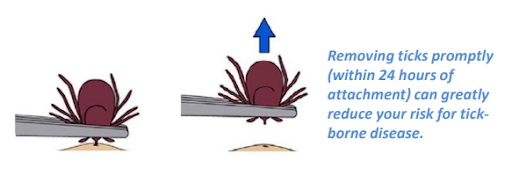 With summer in full swing, we are all eager to lace up our shoes and get out on the nature trails; however, one thing to keep an eye out for are ticks, which are a major vector for various dangerous diseases, such as Lyme disease, anaplasmosis, and babesiosis, among other diseases becoming more common.
With summer in full swing, we are all eager to lace up our shoes and get out on the nature trails; however, one thing to keep an eye out for are ticks, which are a major vector for various dangerous diseases, such as Lyme disease, anaplasmosis, and babesiosis, among other diseases becoming more common.
Here in Michigan, we have over 20 different species of ticks across the state, five of which are to be concerned about; 1. American dog tick, 2. blacklegged (deer) tick, 3. lone star tick, 4. woodchuck tick, and 5. brown dog tick. Although not all of Michigan is infected with ticks, the rising temperatures and humidity caused by climate change are pushing the boundaries of these ticks out to new parts.
Here are a few tips to keep yourself safe and what to do if you find a tick on you.
How to Keep Yourself Safe on the Trails
Before
- Wear a long-sleeved shirt, as well as long pants tucked into high socks
- Wear white or light colored clothing to make it easier to spot ticks
- Wear high ankle shoes/boots, no bare feet or sandals
- Spray insect repellent with at least 20% DEET, and treat clothes with permethrin
During
- Walk in the middle of the cleared trails, away from tall grasses and bushes
- Constantly check yourself for ticks, especially in the hot-spot areas where clothes meet
- Carry a tweezer with you in a ziplock bag
After
- Thoroughly check your clothes and gear before entering your home.
- Immediately take a shower and further check for ticks
- Take all clothes and throw into a hot dryer for at least 10 minutes to kill off any hiding ticks
But I Found a Tick and Need to Remove It!
Follow these guidelines on removal and disposal of ticks from the CDC:
- Use clean, fine-tipped tweezers to grasp the tick as close to the skin’s surface as possible.
- Pull upward with steady, even pressure. Don’t twist or jerk the tick; this can cause the mouth-parts to break off and remain in the skin. If this happens, remove the mouth-parts with tweezers. If you cannot remove the mouth easily with tweezers, leave it alone and let the skin heal.
- After removing the tick, thoroughly clean the bite area with your hands with rubbing alcohol or soap and water.
- Never crush a tick with your fingers. Dispose of live tick by
-
- Putting it in rubbing alcohol,
- Placing it in a sealed bag/container,
- Wrapping it tightly in tape, or
- Flushing it down the toilet
After removing the tick, monitor the affected area for several weeks afterwards. If you experience a fever or rash, tell your doctor when and where the bite happened.
More Resources:
Michigan Department of Health & Human Services – Michigan’s Five Most Common Ticks – pdf
https://www.michigan.gov/mdhhs/safety-injury-prev/environmental-health/Topics/mitracking/ticks


 RSS Feed
RSS Feed